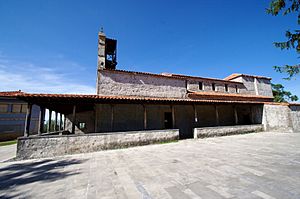Church of Santiago de Gobiendes facts for kids
Quick facts for kids Church of Saint James of GobiendesIglesia de Santiago de Gobiendes |
|
|---|---|
 |
|
| Religion | |
| Affiliation | Roman Catholic |
| Province | Asturias |
| Ecclesiastical or organizational status | Church |
| Year consecrated | 9th century |
| Location | |
| Location | |
| Architecture | |
| Architectural type | Church |
| Architectural style | Pre-Romanesque |
| Specifications | |
| Length | 26 metres (85 ft) |
| Width | 12 metres (39 ft) |
| Width (nave) | 8.6 metres (28 ft) |
The Church of Saint James of Gobiendes (known in Spanish as Iglesia de Santiago de Gobiendes) is an old Roman Catholic church. It is located in a place called Gobiendes, which is close to Colunga in Asturias, Spain. This church is special because it was built a very long time ago, in the 9th century.
It is a great example of Pre-Romanesque architecture. This means it was built before the Romanesque style became popular. The church's design shows the unique building style of Asturian architecture from that time.
Contents
What is Pre-Romanesque Architecture?
Pre-Romanesque architecture refers to buildings made in Europe after the Roman Empire fell. This was before the Romanesque style became common around the 11th century. In Spain, especially in Asturias, this style has its own special features. These include strong stone walls and unique arches.
Asturian Architecture Style
Asturian architecture is a specific type of Pre-Romanesque style. It developed in the Kingdom of Asturias in northern Spain. This kingdom existed from the 8th to the 10th centuries. Churches from this period often have a rectangular shape. They also feature three parts inside, separated by arches.
History of the Church
The Church of Saint James of Gobiendes was built during the time of Alfonso II of Asturias. He was a king who ruled Asturias from 791 to 842 AD. This makes the church over 1,200 years old! It has stood for many centuries.
Important Renovations
Over the years, the church has been updated and repaired several times. A big remodeling project happened in 1853. Later, more restoration work was done in 1946. The church was also carefully restored again in 1983. These efforts help keep this historic building safe and strong for future generations.
See also
 In Spanish: Iglesia de Santiago (Gobiendes) para niños
In Spanish: Iglesia de Santiago (Gobiendes) para niños
- Asturian architecture
- Catholic Church in Spain
References

